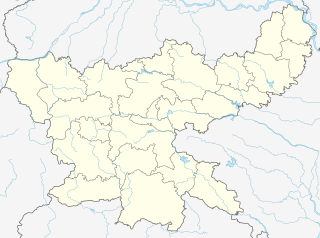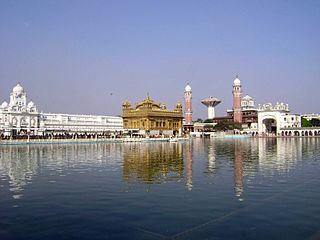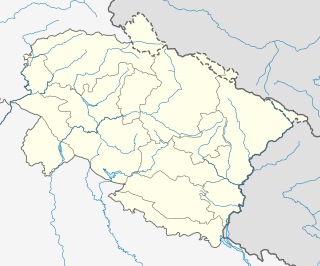Related Research Articles

Nankana Sahib is a city and capital of Nankana Sahib District in the Punjab province of Pakistan. It is named after the first Guru of the Sikhs, Guru Nanak, who was born in the city and first began preaching here. Nankana Sahib is the most important religious site for the Sikh religion. It is located about 91 km (57 mi) west of Lahore and about 75 km (47 mi) east of Faisalabad. According to the census of 2017 the city has a population of 79,540 inhabitants. Until 2005, it was the part of Sheikhupura District.
A gurdwara is a place of assembly and worship for Sikhs. Sikhs also refer to gurdwaras as Gurdwara Sahib. People from all faiths are welcomed in gurdwaras. Each gurdwara has a Darbar Sahib where the current and everlasting guru of the Sikhs, the scripture Guru Granth Sahib, is placed on a takhat in a prominent central position. The raagis recite, sing, and explain the verses from the Guru Granth Sahib, in the presence of the congregation.
The following outline is provides an overview of Sikhism, or Sikhi.

Takht Sri Patna Sahib also known as Takhat Sri Harimandir Ji, is a Gurdwara in the neighbourhood of Patna Sahib, India. It was to commemorate the birthplace of Guru Gobind Singh, the tenth Guru of the Sikhs on December 1666. It was built by Maharaja Ranjit Singh (1780-1839), the first Maharaja of the Sikh Empire, who also built many other Gurdwaras in the Indian subcontinent. The current shrine of Patna Sahib or Takht Sri Harmandirji Sahib was built in the 1950s.
The Sikh Rehit Maryada is a code of conduct and conventions for Sikhism. The final version of the Rehat Maryada was approved by the Shiromani Gurdwara Parbandhak Committee, Amritsar in 1945. The Rehat Maryada was created to provide guidance to Sikhs on practical and functional aspects of daily life, including the operations of Sikh Gurdwaras, and religious practices to foster cohesion throughout the community.

Gurdwara Pahila Bara, commonly known as Gurdwara Gai Ghat, is a holy Gurdwara of Sikh religion. It is located in the city of Patna, Bihar, India and dedicated to Guru Nanak Dev. The Gurdwara is part of "Guru Circuit" - A Government of Bihar initiative connecting important Sikh religious destinations in Bihar to attract more pilgrims.
Bihar in eastern India is one of the oldest inhabited places in the world with a history going back 3000 years. The rich culture and heritage of Bihar is evident from the innumerable ancient monuments that are dotted all over the state. Bihar is home to many tourist attractions and is visited by large numbers of tourists from all over the world. Around total 6 million tourists visit Bihar every year.
Hinduism is the most followed religion in Bihar, followed by nearly 82.7% of total population as per 2011 Census. Islam is the second-most followed religion which is followed by nearly 16.8% of population. There is also a significant population of Jains and Christians in the state.

Hunterganj, is a historic town in the Chatra subdivision of the Chatra district, Jharkhand, India.

Hazur Sahib, also known as Takht Sachkhand Sri Hazur Abchalnagar Sahib, is one of the five takhts in Sikhism. The gurdwara was built between 1832 and 1837 by Maharaja Ranjit Singh (1780–1839). It is located on the banks of the Godavari River at the city of Nanded in the state of Maharashtra, India.
The Akali movement, also called the Gurdwara Reform Movement, was a campaign to bring reform in the gurdwaras in India during the early 1920s. The movement led to the introduction of the Sikh Gurdwara Bill in 1925, which placed all the historical Sikh shrines in India under the control of Shiromani Gurdwara Parbandhak Committee (SGPC).
Kartar Singh Jhabbar was a Sikh leader known for his role in the Gurdwara Reform Movement of the 1920s.

A takht, or taḵẖata literally means a throne or seat of authority and is a spiritual and temporal centre of Sikhism. There are five Takhts, which are five gurudwaras that have a very special significance for the Sikh community. The first and the most important was established by Guru Hargobind in 1609, 'Akal Takht' and is just opposite the gate of Harmandir Sahib – The Golden Temple, Amritsar. While the Harmandir Sahib, or Golden Temple, represents Sikh spiritual guidance, the Akal Takht symbolizes the dispensing of justice and temporal activity. It is the highest seat of temporal authority of the Khalsa and the seat of the Sikh religion's earthly authority. There, the Guru held his court and decided matters of military strategy and political policy. Later on, the Sikh Nation took decisions here on matters of peace and war and settled disputes between the various Sikh groups. The Sarangi singers sung the ballads of the Sikh Gurus and warriors at the place and robes of honour (saropas) were awarded to persons who rendered distinguished services of the community of men in general. In December 2010, the Deccan Odyssey train, taken on charter from Government of Maharashtra, started with the aim to have a journey across four Sikh takhts, with a flight by devout and sightseers to the fifth takht. A special train named Panj Takht Special train for the pilgrimage of five Sikh takhts, was flagged off on 16 February 2014.
The Sikh Gurdwaras Act, 1925 was a piece of legislation in British India which legally defined Sikh identity and brought Sikh gurdwaras under the control of an elected body of orthodox Sikhs.

Patna City, popularly known as Patna Saheb or Patna Sahib, is a neighbourhood in Patna, Bihar, India. It is regarded as very sacred by the Sikhs in India. The tenth Guru of the Sikhs, Guru Gobind Singh was born there. The Patna Saheb Gurudwara is considered to be one of the holiest of the five "Takhts" or seat of authority of the Sikhs. The place is named Harminder Takht though the Sikhs respectfully call it Patna Sahib. The famous Guru Gobind Sahib Gurudwara is an important shrine for Sikhs from all over the world. Ashok Rajpath (road) connects Patna City to Patna.

The 350th Prakash Parv or birth anniversary of Guru Gobind Singh ji was celebrated in January 2017 in Patna, India. 2017 is the year of the 350th anniversary of the 10th Sikh Guru, a spiritual master, warrior, poet and philosopher. At the date of this anniversary, a number of events was organized on the occasion in Patna marking a grand celebration in their history.

Lakhpat Gurdwara Sahib or Gurdwara Pehli Patshahi is a Gurdwara, a place of worship for the Sikhs, located in Lakhpat of Kutch district, Gujarat, India. Guru Nanak on his way to Mecca stayed over in the town during his second (1506-1513) and fourth (1519-1521) missionary journey called Udasis. It is believed that he had visited the site during his fourth journey. The descendants of the host established Gurdwara here in early 19th century. This Gurdwara have his relics like wooden footwear and palkhi (cradle) as well as manuscripts and markings of two important heads of Udasi sect. The site is worshiped by the Udasi sect and initially it was maintained by them. Now it is maintained by local Sikh community and Gurdwara Shri Guru Nanak Singh Sabha of Gandhidham. The Gurdwara is the State Protected Monument (S-GJ-65) by the state archeological department. It has won the UNESCO Asia-Pacific Award in 2004 of Distinction for conservation after the earthquake in 2001.

The Gurdwara Gyan Godri Sahib, also known as Gurdwara Sri Gyan Godri Sahib, meaning "treasure of knowledge" was one of the holiest Gurdwara at Har Ki Pauri, Haridwar in the state of Uttarakhand, India. It existed at the place where The Bharat Scouts and Guides office exists today at the market in Subhash Ghat of Har Ki Pauri which is verified by Municipal Corporation Haridwar records of 1935.